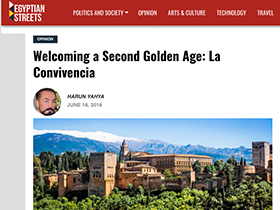
“La Convivencia” refers to a period of time when Muslims, Jews and Christians lived peacefully together in Spain, under Muslim rule. Over the course of seven centuries, members of the three Abrahamic religions worked together and developed one of the most advanced parts of Islamic civilization our world has ever witnessed. It was called al-Andalus.
Muslims rule in Spain, which began in the 8th century, gave way to a glorious civilization of science and culture that left an indelible mark on the world’s history. Indeed, the Muslims’ influence had been so great that the scientific and philosophical achievements of al-Andalus contributed to what is known today as the ‘European Renaissance’.
This was at a time when Europe was fighting the dark days of the Middle Ages. Wars, conflicts and diseases were tearing the continent apart, while al-Andalus, with a population of 5.6 million, had a level of civilization that could rival the modern cities of today. With the exception of a few instances of disputes, it was a splendid example of a modern civilization with canals, aqueducts and underground water conduits. The city of Cordoba for instance, had 200,000 houses, 600 mosques, 900 public baths, 50 hospitals, 70 libraries –the caliph’s personal library alone held 400,000 volumes-, and 10,000 street lamps.
The Jewish statesman Hasdai ibn Shaprut described Sepharad (the Jewish name for al-Andalus) in the following way:
The land is rich, abounding in rivers, springs, and aqueducts; a land of corn, oil, of fruits and all manner of delicacies; it has gardens and orchards, fruitful trees of every kind, including the leaves of trees upon which the silkworm feeds…. There are also found among us mountains…with veins of sulphur, porphyry, marble and crystal. Merchants congregate in it and traffickers from the ends of earth…bringing spices, precious stones, splendid wares for kings and princes…’
The German nun Hrotswitha of Gandersheim was also very impressed with Cordoba and said: ‘The new imperial city, the glittering ornament of the world, shining in the western regions.’
Al-Andaluss’ richness and beauty came from contributions by the members of three divine and Abrahamic religions. The intensity of literary production, especially in the 10th Century, was a result of cultural cooperation between Muslim, Jewish and Christian scholars. Particularly during the reign of Abd al-Rahman III and his Jewish vizier Hasdai ibn Shaprut, Arabs, Berbers, Jews, and the Christian Iberio-Hispanic population were given equal opportunity in government services and public affairs. Christians and Jews, in particular , were classified as protected people. The renowned Jewish philosopher Maimonides explains as follows: ‘Judaism probably welcomed the conquest of Spain by the Muslims. With the Muslim conquest began a Golden Age of freedom and tolerance for Jews. They freely entered the fields of government, science, medicine, and literature.’ Jews and Christians were free to maintain their beliefs and practices and indeed the compassion Islam displayed towards the non-Muslim inhabitants led many of them to embrace Islam.
However, al-Andalus was far from the only example of the shining cities of Islamic brilliance. Baghdad, with its House of Wisdom, was to the ancient world what New York is to the modern world. Scholars, artists and scientists from every far land, regardless of their faith or gender, flocked to this beautiful city that thrived on knowledge, art and culture. Al-Fustat of Egypt was another, albeit a lesser known, example of an Islamic center of aestheticism and art. In 987, the geographer Ibn Hawkal wrote that the city had ‘shaded streets, gardens and handsome markets with houses up to seven stories tall, and large enough to accommodate 200 people.’ Nasir-i-Khusrow, some 70 years later, also expressed his astonishment at the beauty of the city, and mentioned ‘iridescent pottery so delicate he could see his hand through it, costly green transparent glass, rock crystal, tortoise shell and a profusion of fruits and flowers and vegetables even during the winter months.’
Al-Azhar in Cairo, which is today the world’s most famous Islamic university, was built as a mosque during the rule of the Fatimids; it was opened for prayers first on 7 Ramadan 361 H / June 22, 972 CE. Cairo saw a myriad of rulers that were committed to making the institution the best center of Islamic education, which helped elevate Al-Azhar’s status to that of a magnet center for education and talent. When the Abbasid caliphate came to an end in 1258, Mamluk Sultan Baybars invited the Abbasid family to Cairo, which triggered a massive movement of Islamic scholars to Egypt. Around the same time, the Islamic emirates in Spain were being attacked by Castillian armies and the scholars of Cordoba, Seville and Valencia also turned to Cairo as their destination, making Cairo the new center of Islamic learning.
It is possible to extend the list. However, even these few examples give a clear message: as long as Muslims abide by the Qur’an, the peaceful atmosphere of harmonious co-existence would exist like it did during La Convivencia, and it would be followed by the examples of flourishing cultures in Baghdad or Al-Fustat.
Adnan Oktar's piece in Egyptian Streets:
https://egyptianstreets.com/2018/06/18/welcoming-a-second-golden-age-la-convicencia/


